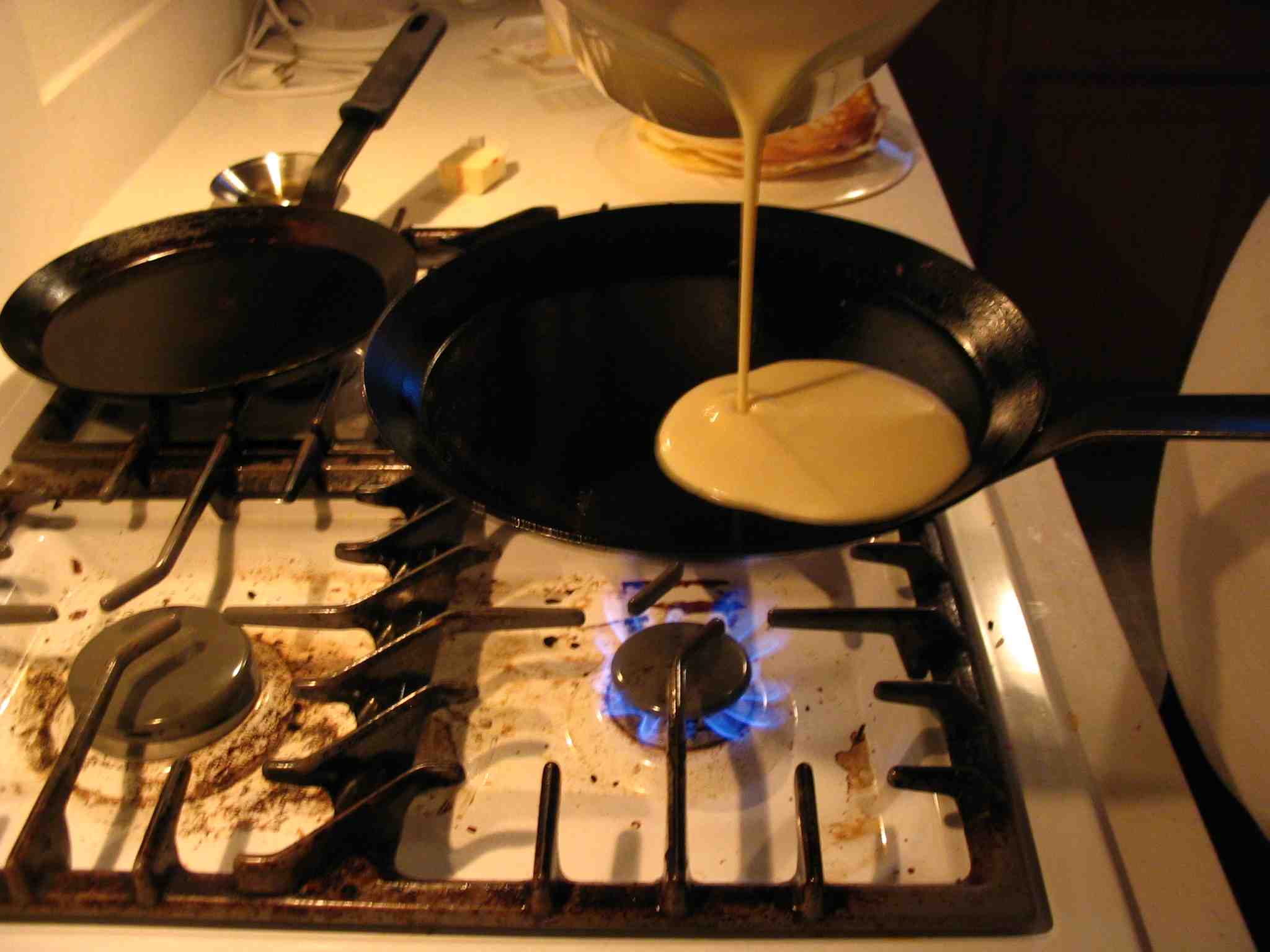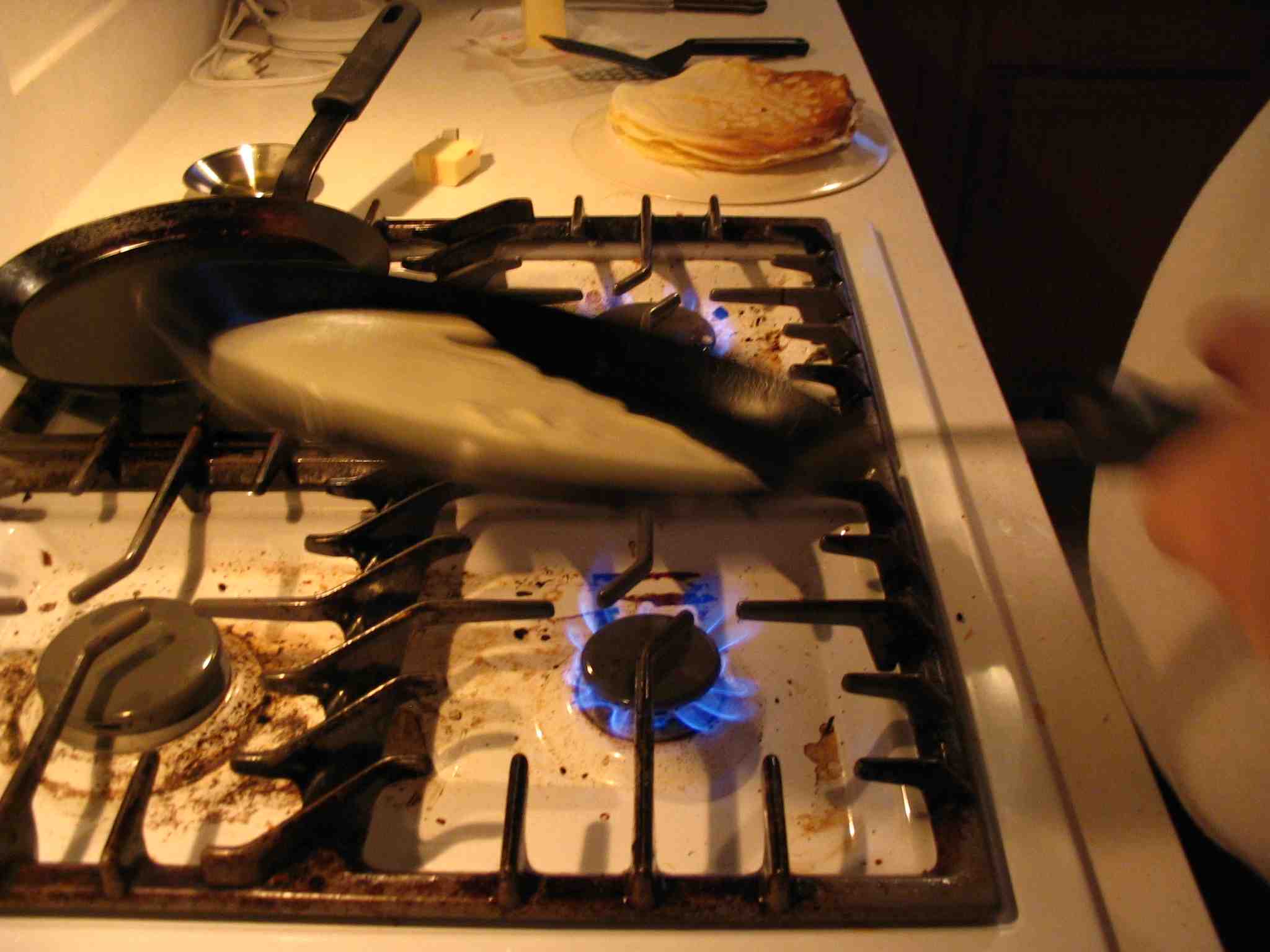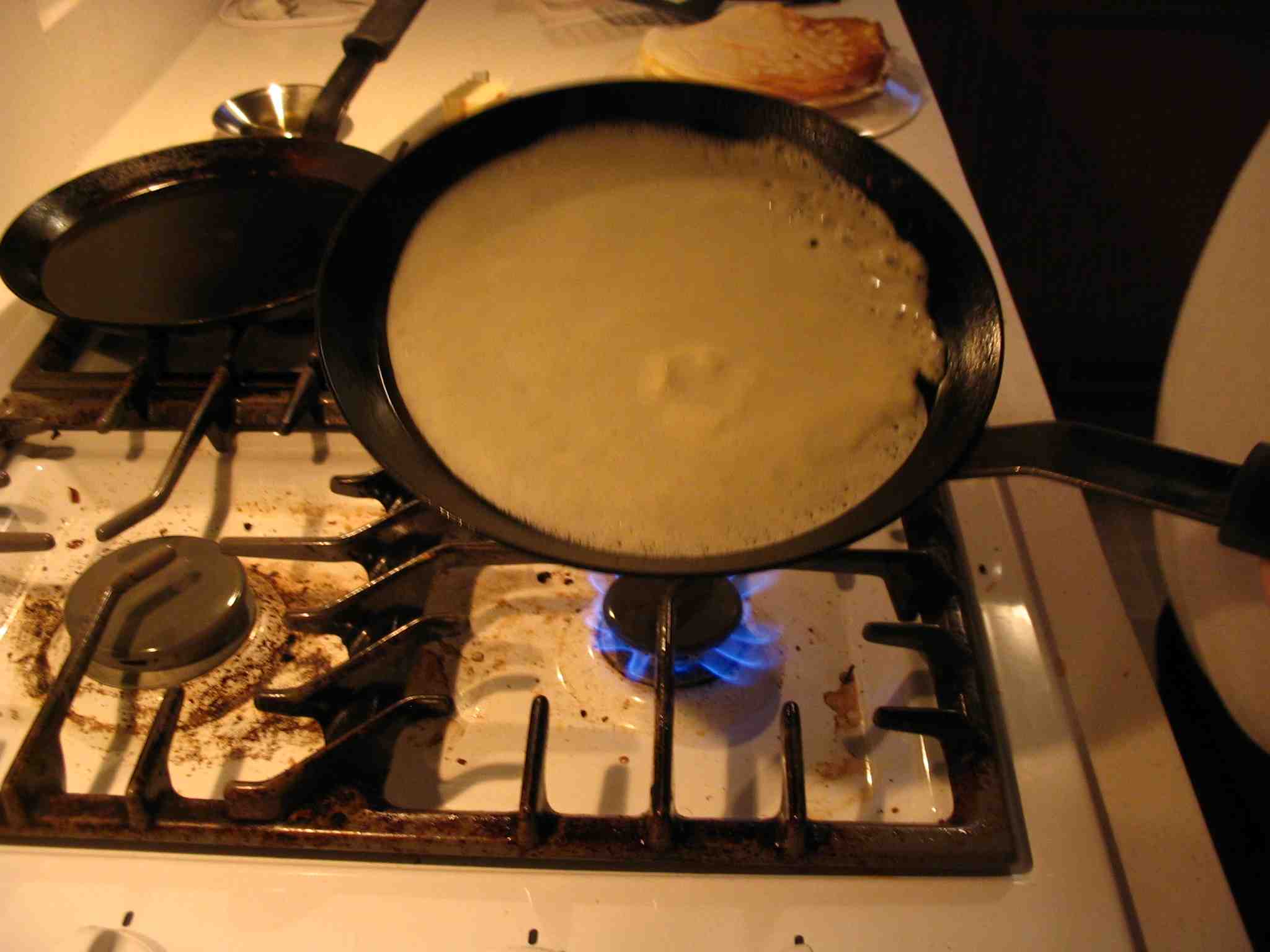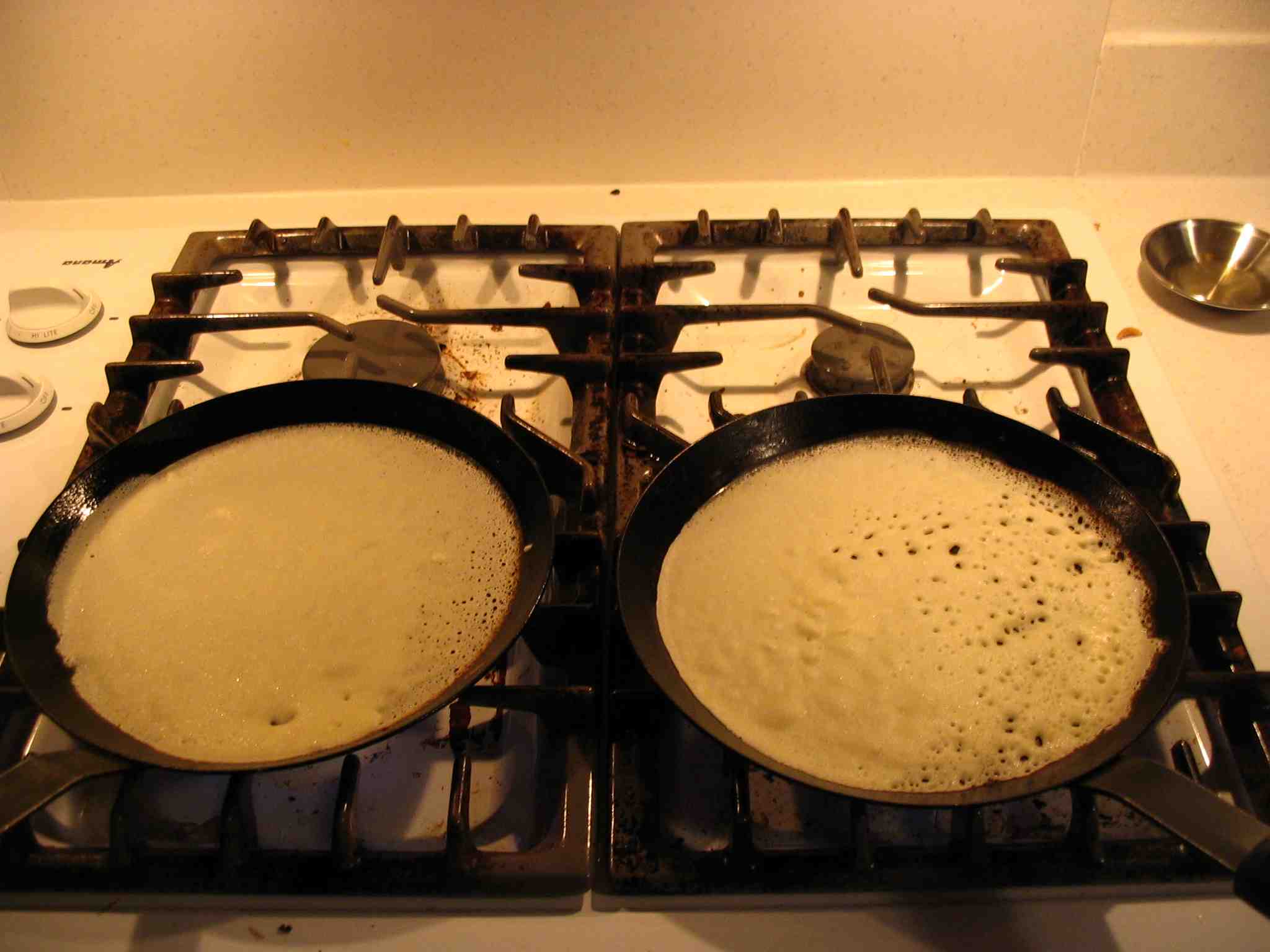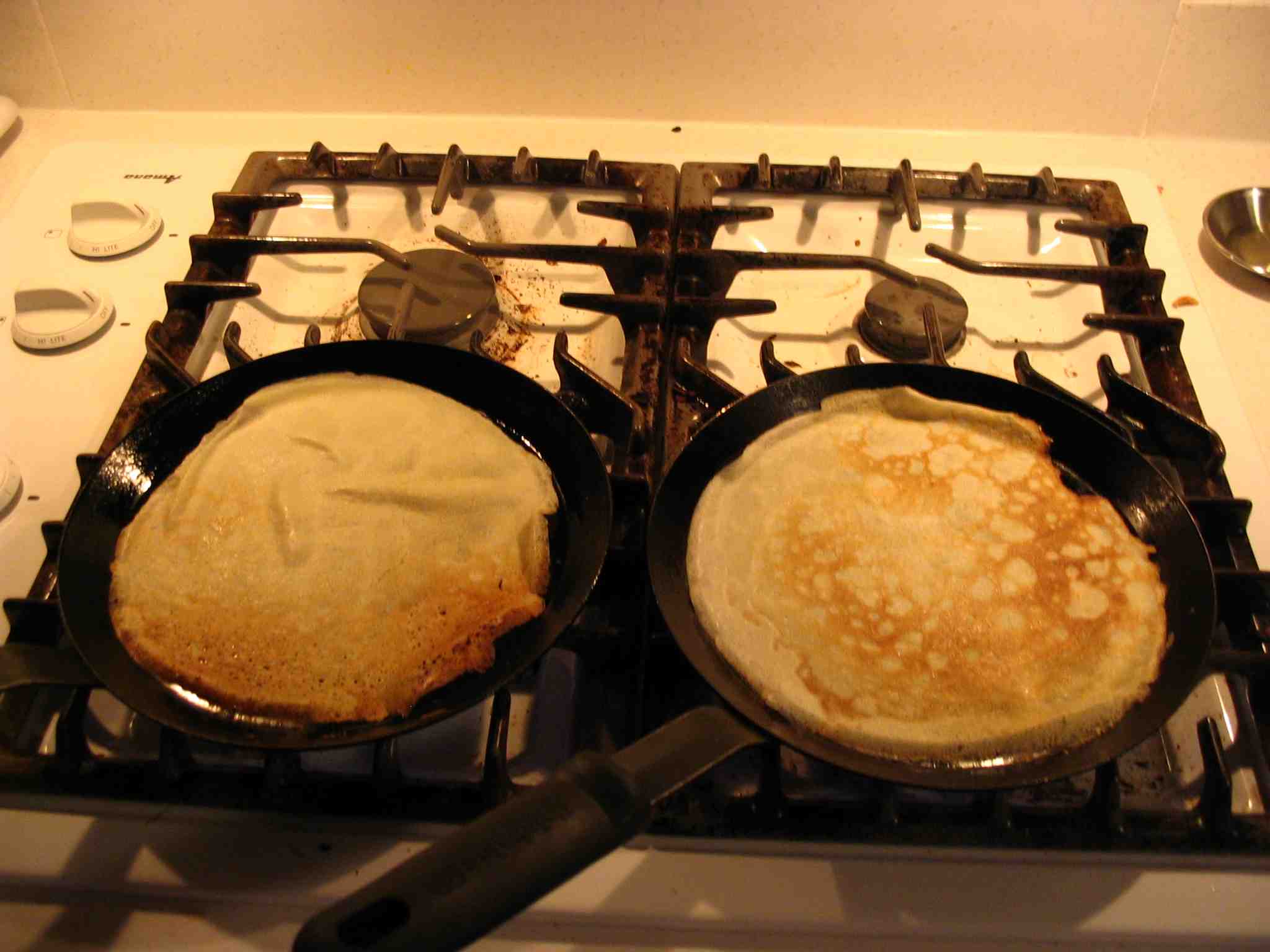This is version 2 for me. After 25+ years of making crêpes with my
first recipe, I finally decided to adjust it after my daughter went to the web
and couldn't find it. So she found another one and used it instead. Her
crêpes were buttery and more delicious I thought than mine. So, I
adjusted my recipe to use butter and more eggs.
Savory crêpes
For a savory crêpe, common at crêperies throughout
France and Québec, omit ½ the sugar and substitute vegetable oil
for part or all of the butter (unless your savory dish would benefit from the
butter) in the recipe below. Also, substitute buckwheat flour for ½ or
even all of the flour in this recipe for authentic Breton-style Saracen
(sarrasin) crêpes. Stuff with chicken or broccoli and pour a
Béchamel sauce over it, or do a breakfast with eggs, bacon and
cheese. Etc. There is no limit to what you can stuff crêpes with.
Now, if these pages were widely perused by French and hosted commentaries, very
rude remarks concerning this Breton crêpe would be inscribed.
First, some are indignant that crêpe is misapplied to the Breton
galette. Second, some swear up and down that water and not milk must be
used. Last, many think it's a great act of impiety to add wheat flour.
Au fond, je m'en fous : Ils ont raison ; ils ont tort.
It's like Italians making pasta with wheat flour skipping the semolina. It
happens. Who cares?
Ultimately, you'll find plenty of recipes for Breton crêpes that
match mine. Still others call them by this name, they are sold under this name
at crêperies all over France and Québec, many swear by
using milk (it's Brittany after all: with Normandie the two make Wisconsin
little more than a footnote in the annals of dairy history), and many think
that they taste better when a portion of wheat flour is added. I like buckwheat
and I like wheat flour. For savory, I would probably not choose wheat flour.
For dessert crêpes, I like both, but I would not be averse to bumping the
sugar content to take the edge off the buckwheat (or off the whole wheat flour
if I were using that).
Crêpe secrets
Great crêpes are paper-thin and evenly round.
There are two great secrets to crêpe making. First and foremost is
the brute skill that comes with practice. I give a method here and illustrate
it. If you're good, you can cook decent crêpes on any
surface, but the second trick will secure you a legend as a crêpe
maker.
The second secret is the pan. Find a steel (not stainless) crêpe
pan from a kitchen supply place and season it well by heating it evenly after
coating it with vegetable oil—just as you would for cast iron cookware.
Rinse it, wipe it down and repeat. Never scour it unless you make a mistake and
burn it, then start over again seasoning it. My pans are absolutely black after
years of crêpe making. They work perfectly.
If you really get into crêpes, don't use Teflon-coated or
other non-stick surface pans. These produce a shiny crêpe that
doesn't brown very well. They also tend to be less robust and require
more protective care in storage than steel ones.
Yield
This left recipe yields about 30 9" diameter crêpes. The one on
the right is half that size and for savory crêpes.
Ingredients
| 4 | eggs |
| a few drops | vanilla extract |
| 2½ cups | milk |
| 2 cups | flour |
| ½ tsp | salt |
| ½ cup | white granulated sugar |
| 3 tbsp | melted butter |
Preparation
1. Use a standard blender and its 2-quart mixing container to beat the
eggs—just a few pulses. Add a few drops of vanilla and the milk. Pulse a
few times.
2. Add the flour and pulse until well incorporated. Then add the remaining
ingredients in order pulsing all the while. Ensure no flour or other dry
ingredient encrust itself on the side of the container.
If you find the effect of bubbles in your batter unacceptable, set this mixture
aside in the refrigerator for an hour or even overnight. You will see the
effect of bubbles in my pictures here. This is because I don't mind them.
You are ready to cook, however, ensure that the batter hasn't thickened
too much while at rest as flour tends to absorb the milk over time. The batter
should be very liquid as compared to pancake batter. Batter you let stand in
the refrigerator overnight will inevitably need to be thinned.
Use a folded paper towel to apply and maintain vegetable oil on the cooking
surface. There should never be so much oil as to “sautée”
the crèpe.
|
|
| 1-2 | eggs |
| 2 tbsp | butter |
| 1 tbsp | sugar |
| — | salt |
| 1 cup | buckwheat flour |
| 1½ cups | milk |
| ½ cup+ | water to thin |
Preparation
1. Mix ingredients in order in blender. Cook in crêpe pan as expected.
Keep adding water between crêpes until thin enough.
2. Caution: because buckwheat has no gluten, increasingly thinner
crêpes will be harder to turn without tearing them apart. One solution
is to peel the crêpe up, then grab it quickly with fingers from both
hands, lift and turn over.
3. Buckwheat crêpes need to cook hotter and a little longer than
crêpes made from wheat flour.
If you like a little sweeter, add a bit more sugar. I found this was enough.
Do not decrease for savory use because this will affect browning and fail to
take the edge off the buckwheat flavor.
I butter very heavily (must be a British thing1), then sprinkle
liberally with powdered sugar.
1 "Ever had toasted tea cakes, Douglas?
The secret's in the butter. You've gotta have so much it runs down your
fingers. Should we go and find some?"
(Warnie Lewis, Shadowlands, 1993)
|
Gluten-, dairy- and egg-free (vegan) modifications
I haven't tried this yet, however, I have experimented successfully with
applesauce as an egg replacement in baking. I will come back here and correct
this recipe if needed. The point is that buckwheat isn't wheat at all. It's in
fact a grass and it is gluten-free.
| 2 tbsp | applesauce |
| 2 tbsp | fat (margarine, shortening—some fat) |
| 1 tbsp | butter |
| — | salt |
| 1 cup | buckwheat flour |
| 1½ cups | oat, flax, almond or coconut milk |
| ½ cup+ | water to thin |
